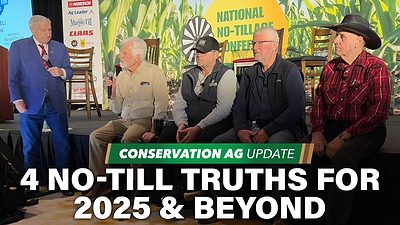After more than 20 years of no-tilling corn and soybeans, Prairie City, Iowa, farmer Gordon Wassenaar decided in the fall of 2010 to shift to strip-till.
"I use a ‘weed-and-feed’ program, applying liquid nitrogen along with herbicide as soon as the corn comes up. I apply this when the corn reaches 3 to 4 inches."
— Gordon Wassenaar,
Prairie City, Iowa, strip-tiller
RTK technology made the switch rather easy. He continued to apply anhydrous ammonia as he had in previous falls, with a 16-row, DMI toolbar with 30-inch spacings, equipped with moleknives and heavy covering discs. Wassenaar pulls the DMI toolbar with a 350-horsepower Case IH 335 tractor.
"The guidance system allowed me to plant the corn into the fertilizer strip in the spring of 2011," Wassenaar says. "In previous years, we weren’t always getting the corn planted into the strip where we applied anhydrous in the previous fall. So, for us, it was just plain common sense to make this switch to strip-tilling corn."
Wassenaar applies 140 to 150 pounds of nitrogen per acre, using N-Serve on 100% of the corn ground. With all of the wet springs he's had, more farmers are thinking about using nitrogen inhibitors, he says.
"We place the anhydrous at least 8 inches deep with the moleknives," he says. "The moleknives have a wide chisel point and the anhydrous ammonia will stay down in the soil in the cavity that the knives make."
Wassenaar plants corn on 30-inch spacings and soybeans on 15-inch spacings using a Kinze Interplant planter. It has 16 rows for corn and 30 rows for 15-inch soybeans.
Wassenaar says that after just one year of strip-tilling corn it was too soon to see if there was a difference in yields due to the change from no-till.
"I think there will be a bit of a yield increase, but it’s too early to tell," he says. "Every year is different. There’s no ‘magic bullet’ when you farm. You’re just making a lot of little, positive changes."
Use Multiple Modes
Wassenaar believes in the value of marrying conservation tillage with precision technology and crop biotechnology to maximize yields and profitability and protect the soil.
And he’s taking glyphosate-resistant weeds seriously. He was stunned to learn from a top-notch Southern farmer that he had to quit growing soybeans entirely because of glyphosate-resistant weeds.
So Wassenaar uses herbicides with multiple modes of action in an attempt to ward off resistant weeds.
"I use a 'weed-and-feed' program, applying liquid nitrogen along with herbicide as soon as the corn comes up,” he says. "I apply this when the corn reaches 3 to 4 inches."
Wassenaar includes up to four herbicides with the liquid nitrogen. For corn, he uses acetechlor and atrazine, along with Basis and Hornet for grass and for broadleaves.
For burndown in soybeans, he uses Sonic, which is comprised of the active ingrediants in FirstRate and Authority, along with 2,4-D and Roundup. Then he applies Roundup and Cadet post-emergence for broadleaves.
"Cadet gives you a little more firepower to control waterhemp," Wassenaar says.
It's important to manage weeds in general — and waterhemp in particular — with multiple modes of action, he adds.
"I've heard too many horror stories of weed resistance from farmers down in the South," he says. "They told me, 'Your time’s coming with glyphosate resistance.' Too many farmers are only using Roundup, Roundup, Roundup for corn and soybeans."
Wassenaar says managing weeds means getting them when they’re small and growing rapidly.
“If glyphosate resistance becomes really bad, then I’d say it will not be possible for me to strip-till,” he says. “But I don’t want to go back to tillage to control weeds.
Cover-Crop Option
For the moment, Wassenaar says he’s not extremely worried about glyphosate resistance on his farm.
In addition to using herbicides with different modes of actions and rotating the herbicide-resistant traits in corn hybrids, he’s looking forward to new herbicide-resistant traits that are coming to the market.
“I think the introduction of Dow’s 2,4-D-resistant trait for corn, will buy us some more time,” Wassenaar says. “For a corn grower, the 2,4-D trait, along with atrazine, will give us a potent combination against weeds. This could give us more time for companies to develop a herbicide alternative to glyphosate.”
“With strip-till, my ultimate goal is to use a cover crop that creates a mat on the ground that holds the soil in place and suppresses weeds. We’re having more storms and more intense ones, and we need to protect the soil.”
Fine-Tuning Strip-Till
Along with strip-tilling anhydrous in the fall, Wassenaar comes back in the spring with 25 to 30 pounds of liquid nitrogen per acre on corn ground. He also broadcasts 2 years' worth of phosphate in potash every other year, either in the fall or very early in the spring.
There’s enough phosphorus and potassium for corn and soybeans in the next 2 years, he says.
Wassenaar’s also thinking about whether he should apply phosphate and potash in the strip.
“I’ve got to learn how to place fertilizer better,” Wassenaar says. “That includes how much fertilizer and when to apply it. My goal in the future is to place nitrogen, phosphate and potash at the same time when strip-tilling in the fall. But pulling a dry fertilizer cart will take more horsepower. And I may also start using nitrogen-sensing devices to feed the corn during the summer.”
In the upcoming growing season, Wassenaar also plans on doing onfarm research in soybeans. He will compare two treatments and a check. One treatment will be with fungicides and another will be with fungicides and micronutrients.
“Ag suppliers are getting geared up to put on micronutrients,” he says. “So I want to check them out on my farm.”





